Among the best known monkeys, the Panamanian white-faced capuchin is recognized as the typical companion to the organ grinder. In recent years the species has become popular in North American media, particularly in the Pirates of the Caribbean film series. It is a highly intelligent monkey and has been trained to assist paraplegic persons. It is a medium-sized monkey, weighing up to 3.9 kg (8.6 lb). It is mostly black, but with a pink face and white on much of the front part of the body, giving it its common name. It has a distinctive prehensile tail that is often carried coiled up and is used to help support the monkey when it is feeding beneath a branch.
In the wild, the Panamanian white-faced capuchin is versatile, living in many different types of forest, and eating many different types of food, including fruit, other plant material, invertebrates, and small vertebrates. It lives in troops that can exceed 20 animals and include both males and females. It is noted for its tool use, including rubbing plants over its body in an apparent use of herbal medicine, and also using tools as weapons and for getting to food. It is a long-lived monkey, with a maximum recorded age of over 54 years.
Panamanian white-faced capuchins are highly social, living in groups of 16 individuals on average, about three quarters of which are females. Groups consists of related females, immigrant males, and offspring. On average, females birth offspring every 27 months even though they mate throughout the year. Females tend to stay within their original group while males leave their natal group when they are 4 years old and change groups every 4 years after. Both male and female capuchins exhibit different dominance behaviors within the group.

Taxonomy
The Panamanian white-faced capuchin was previously considered a subspecies of the Colombian white-headed capuchin, Cebus capucinus imitator.[clarification needed]
In 2012 a study by Boubli, et al. demonstrated that C. imitator and C. capucinus split up to 2 million years ago.[4][5] Boubli's study also indicated that the Honduran white-faced capuchins, which had previously been considered a to be a possible separate subspecies, C. capucinus limitaneus, was not genetically distinct from the Panamanian white-faced capuchin.[4]
The Panamanian white-faced capuchin is the most well-studied capuchin monkey species.[5] Even though many previous studies were performed using the scientific name C. capucinus, as of 2014 there had been no field studies of the Colombian white-faced capuchin, so all these studies were of the Panamanian white-faced capuchin.[5]
Physical description
Like other monkeys in the genus Cebus, the Panamanian white-faced capuchin is named after the order of Capuchin friars – the cowls of these friars closely resemble the monkey's head coloration.[6][7] The Panamanian white-faced capuchin has mostly black fur, with white to yellow like fur on the neck, throat, chest, shoulders, and upper arms.[8] The face is pink or a white-cream color and may have identifying marks such as dark brows or dark fur patches.[8][9][10] An area of black fur on the crown of the head is distinctive.[8][11] It has a prehensile tail that is often held coiled, giving the white-faced capuchins the nickname "ringtail".[8][12]Adults reach a length of between 335 and 453 mm (13.2 and 17.8 in), excluding tail, and a weight of up to 3.9 kg (8.6 lb).[8][11] The tail is longer than the body, at up to 551 mm (21.7 in) in length.[8][11] Males are about 27% larger than females.[13] The brain of a white-faced capuchin is about 79.2 g (2.79 oz), which is larger than that of several larger monkey species, such as the mantled howler.[11][14]
The Panamanian white-faced capuchin is similar to the Colombian white-faced capuchin in appearance, except that the female Panamanian white-faced capuchins have brownish or grayish elongated frontal tufts, which provide a contrast to the pure white cheeks and throat.[3][15]
Behavior
Social structure
Walking on four limbs
Kinship is an important organizing factor in the structuring of female-female social relationships.[24] Particularly in larger groups, females preferentially associate with, groom, and provide coalitionary support to their matrilineally related female kin. They do not exhibit a similar preference for their paternal half sisters, which may mean that they only are capable of recognizing kinship through the maternal line.[24] Dominance rank is also an important organizing factor, with females more often grooming and associating with females who are closer to them in the dominance hierarchy.[24] Female-female dyads groom far more than male-female and male-male dyads.[25] Coalitionary aggression is common both among males and females, and capuchins seem to have an excellent understanding of the alliance structure in their group. For example, when capuchins are fighting, they sensibly recruit aid from someone who is both higher ranking than they are and also better friends with themselves than with their opponent.[26]
Female capuchins have linear dominance hierarchies.[25][27] In contrast to many Old World monkeys such as macaques, in which females socially inherit the rank just below their mothers and just above their next oldest sisters, capuchins do not have a highly predictable ranking within their matrilines.[24] Males are typically dominant to females.[28] The alpha male is always easy to discern, but there are sometimes ambiguous rankings among subordinate males.[20][29] Male-male relationships are tense, and affiliation between males is typically expressed by resting in contact, playing, or non-conceptive sex rather than by grooming.[29][30] Males cooperate in coalitions against potential predators, and also in defense of the group against other males.[20][29][31] Occasionally male coalitionary aggression becomes so violent that males are killed, particularly if they are encountered roaming the forest unaccompanied by allies.[20][32] Because aggression from other male capuchins is the leading cause of death (aside from poaching by humans, where there is contact between humans and capuchins), male allies are critical for self-defense during migration, and to assist in taking over other groups.[20] Male emigration to a new troop typically occurs about every 4 years, so most males are in constant danger of having to defend themselves against other groups of males.[7][33][33][34][35]
Immigrating males often kill young infants when they take over a group.[20][36][37] Females band together to defend their infants from infanticidal males, but they rarely succeed in saving their infants.[20] Because infants inhibit their mothers from ovulating by nursing frequently, males are able to bring females into estrus earlier by killing the infants and thereby terminating nursing; this has the effect of increasing their breeding opportunities.[20][37][38] Females do often mate with the killers of their infants, and with time, they typically become as supportive of the new alpha male as they had been of the previous one.[20] The alpha male helps defend females from subordinate males within the group as well as from infanticidal males from other groups.[20][39]
Interactions between groups
Panamanian white-faced capuchin troops occupy home ranges of between 32 and 86 hectares (79 and 213 acres).[11] They travel between 1 and 3 kilometres (0.62 and 1.86 mi) daily, averaging 2 kilometres (1.2 mi) per day.[40] Although they engage in activity that has been described as "territorial", more recent research indicates that white-faced capuchin troops tend to behave aggressively to other white-faced capuchin troops regardless of where they meet, and the aggression is not necessarily intended to exclude the other troops from a specific home range.[41]Home ranges overlap extensively,[31][42] so groups are not territorial in the strictest sense of the word. Perhaps because of the intensity of male-male competition and the threat of infanticide, interactions between groups are typically hostile: the males display aggressively toward one another and sometimes engage in physical aggression (even killing an opponent), while females grab their infants and run.[31][32] Typically, males are the primary participants in aggressive intergroup encounters, and it seems likely that males are defending access to the females in their groups.[31] Alpha males, who have the largest reproductive stake in the group, participate at a higher rate than subordinate males.[31] Groups with more males have an advantage over groups with fewer males, but the location of the encounter within the home range matters as well; smaller groups defeat larger groups when the contest occurs in the core or center area of the smaller group's home range.[42]
Interspecific interactions
The Panamanian white-faced capuchin sometimes interacts with other sympatric monkey species. Panamanian white-faced capuchins sometimes travel with and even groom Geoffroy's spider monkeys.[11][40] However, aggressive interactions between the capuchins and spider monkeys also occur.[43] Interactions between the Panamanian white-faced capuchin and mantled howler are infrequent, and sometimes result in the capuchins threatening the larger howlers.[40] However, affiliative associations between the capuchins and howlers do sometimes occur, mostly involving juveniles playing together.[43]Although South American capuchin species often travel with and feed together with squirrel monkeys, the Panamanian white-faced capuchin only rarely associates with the Central American squirrel monkey. This appears to be related to the patchier, more dispersed distribution of food resources in Central America and the fact that there is less dietary overlap between the Central American squirrel monkey and the white-faced capuchin than between their South American counterparts. Therefore, there is less benefit to the Central American squirrel monkey in associating with the Panamanian white-faced capuchin in order to exploit the capuchin's knowledge of food resource distribution. In addition, compared to their South American counterparts, male Panamanian white-headed capuchins are relatively more alert to rival males than to predators, reducing the predator detection benefits that the Central American squirrel monkey receives from associating with the Panamanian white-faced capuchin compared to its South American counterparts. Since the squirrel monkeys generally initiate interactions with the capuchins in South America, the fact that similar associations would impose higher foraging costs and impart fewer predator detection benefits to the Central American squirrel monkey leads to fewer associations with the Panamanian white-faced capuchin.[13][44][45][46]
Several non-primate animal species tend to follow troops of white-faced monkeys or are otherwise attracted by their presence. white-lipped peccaries and agoutis are attracted by feeding white-faced capuchins, looking for fruit that the capuchins drop.[40] Several species of bird are also known to follow Panmanian white-faced capuchins looking for food. These include the double-toothed kite, the white hawk and the sharp-shinned hawk.[40]
Diet
Foraging in the trees
Fruit can make up between 50% and 67% or more of the capuchin's diet.[7] In one study in Panama, white-faced capuchins ate 95 different fruit species.[7] Among its favorite fruits are figs from the family Moraceae, mangos and related fruits from the family Anacardiaceae, the bean-like fruits from the family Leguminosae and fruits from the family Rubiaceae.[48] It will also eat fruits from Euphorbiaceae such as Mexican jumping bean Sebastiania pavoniana.[49] It generally only eats ripe fruit, testing for ripeness by smelling, tasting and prodding the fruit.[7] It typically eats only the pulp and juice, spitting out the seeds and fibers.[7] Other plant matter eaten includes flowers, young leaves, seeds of certain plants, and bromeliads.[7][50] It also uses the bromelids as a water source, drinking the water that gets trapped inside.[7] In Carara National Park the capuchins have a varied diet in addition to the above of banana fruits and flowers, heliconia seeds, huevos de caballo fruits and anacardiaceae stems.[51]
Insect prey eaten includes beetle larvae, butterfly and moth caterpillars, ants, wasps, and ant and wasp larvae.[7] It also eats larger prey, such as birds, bird eggs, frogs, lizards, crabs, mollusks and small mammals.[7][52] The population in Guanacaste, Costa Rica in particular is noted for hunting squirrels, magpies, white-crowned parrots[7] and baby coatis.[53] The amount of vertebrate prey eaten varies by troop.[7] Even neighboring troops can show significant differences in their diets.[47]
The diet can vary between the rainy and dry season. For example, in Guanacaste, Costa Rica the Panamanian white-faced capuchin can eat a wide variety of fruits as well as caterpillars in the early rainy season (June to November).[48] But during the dry season, only figs and a few other types of fruit are available.[48] During the dry season, chitinous insects, ant and wasp larvae and vertebrates become a particularly important part of the Panamanian white-faced capuchin's diet.[48] Access to water can also become an issue during the dry season. The Panamanian white-faced capuchin likes to drink daily, so in forests where water holes dry up during the dry season, there can be competition between troops over access to the remaining water holes.[48]
Tool use
Capuchins are considered among the most intelligent of the New World monkeys; they have been the subject of many studies on behaviour and intelligence. The capuchins' intelligence is thought to be an adaptation to support their feeding habits; they rely on ephemeral food sources which may be hard to find. In one particular study conducted in 2007, capuchins were found to be among the ten most intelligent primates, second to spider monkeys among New World monkeys.[54]The Panamanian white-faced capuchin is known to rub parts of certain plants into their hair. Plants used in this manner include citrus fruits, vines of the genera Piper and Clematis, monkey comb (genus Sloanea), dumb cane and custard apple.[7][52] Ants and millipedes are also used in this way.[7] It is not definitively known what this rubbing is for, but this may deter parasites such as ticks and insects, or it may serve as a fungicide or bactericide or anti-inflammatory agent.[7] Alternatively, it may be a form of scent marking.[7]
The Panamanian white-faced capuchin also uses tools in other ways. It has been known to beat snakes with sticks in order to protect itself or to get the snake to release an infant.[7] In captivity, it has been known to use tools to get to food or to defend itself, and in one case a white-faced capuchin used a squirrel monkey as a projectile, hurling it at a human observer.[7] Some populations also use trees or other hard surfaces as anvils in order to crack mollusks.[52] And it sometimes uses sticks as probes to explore openings.[55]
The Panamanian white-faced capuchin's intelligence and ability to use tools allows them to be trained to assist paraplegics.[56] Other species of capuchin monkeys are also trained in this manner.[57] Panamanian white-faced capuchins can also be trained for roles on television and movies, such as Marcel on the television series Friends.[58] They were also traditionally used as organ grinder monkeys.[59]
Communication
Facial expression
Reproduction
Juvenile in Palo Verde National Park, Costa Rica
Copulation takes about 2 minutes, and the gestation period is 5 to 6 months.[40] Usually a single young is born, but twins occur occasionally. Most births occur during the dry season from December to April.[11][40] The infant is carried across its mother's back for about 6 weeks.[40] After about 4 to 5 weeks it can stray from its mother for brief periods and by about 3 months it can move around independently, although some infants will be mostly independent earlier. Weaning occurs between 6 and 12 months. While the mother rests, the young spends most of its time foraging or playing, either on its own or with other juveniles.[40] Capuchins engage in high levels of alloparenting, in which monkeys other than the mother help care for the infant.[64] Infants are carried by alloparents most often between 4 and 6 weeks in age.[20] Males as well as females engage in alloparenting.[20][40]
Like other capuchin species, the Panamanian white-faced capuchin matures slowly. Sexual maturity can be reached at 3 years.[59] But on average, females give birth for the first time at 7 years old and give birth every 26 months thereafter.[13] Males attain reproductive maturity at 10 years old.[13] The Panamanian white-faced capuchin has a long life span given its size. The maximum recorded life span in captivity is over 54 years.[13]
Distribution and habitat
White-faced capuchin at Frío River, Costa Rica
While the white-faced capuchin is very common in Costa Rica and Panama, the monkey has been largely extirpated from Honduras and much of Nicaragua. Many Honduran capuchins were captured and relocated to the island of Roatán, and many Nicaraguan capuchins were captured and relocated to the island of Ometepe. In Nicaragua, wild capuchins may still be easily spotted in regions around Masaya, as well as around Bluefields and other locations around the South Caribbean coast. They are seen, in the wild, daily by visitors who climb one of the volcanoes on Ometepe Island.[66]
It is found in many different types of forest, including mature and secondary forests, and including evergreen and deciduous forests, dry and moist forests, and mangrove and montane forests.[8][59] However, it appears to prefer primary or advanced secondary forests.[40] Also, higher densities of white-faced capuchins are found in older areas of forest and in areas containing evergreen forest, as well as areas with more water availability during the dry season.[67]
Conservation status
In Manuel Antonio National Park, Costa Rica
Cebus imitator
(Thomas, 1903)

Distribution of Cebus imitator and Cebus capucinus[1]. Cebus imitator covers the Central American portion of the range except the easternmost portion of Panama.
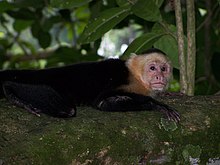

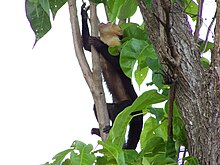
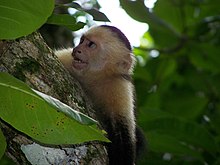

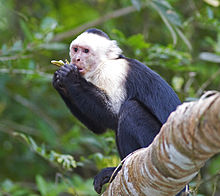
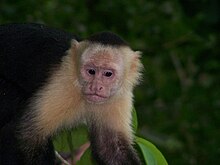
No comments:
Post a Comment
Note: Only a member of this blog may post a comment.